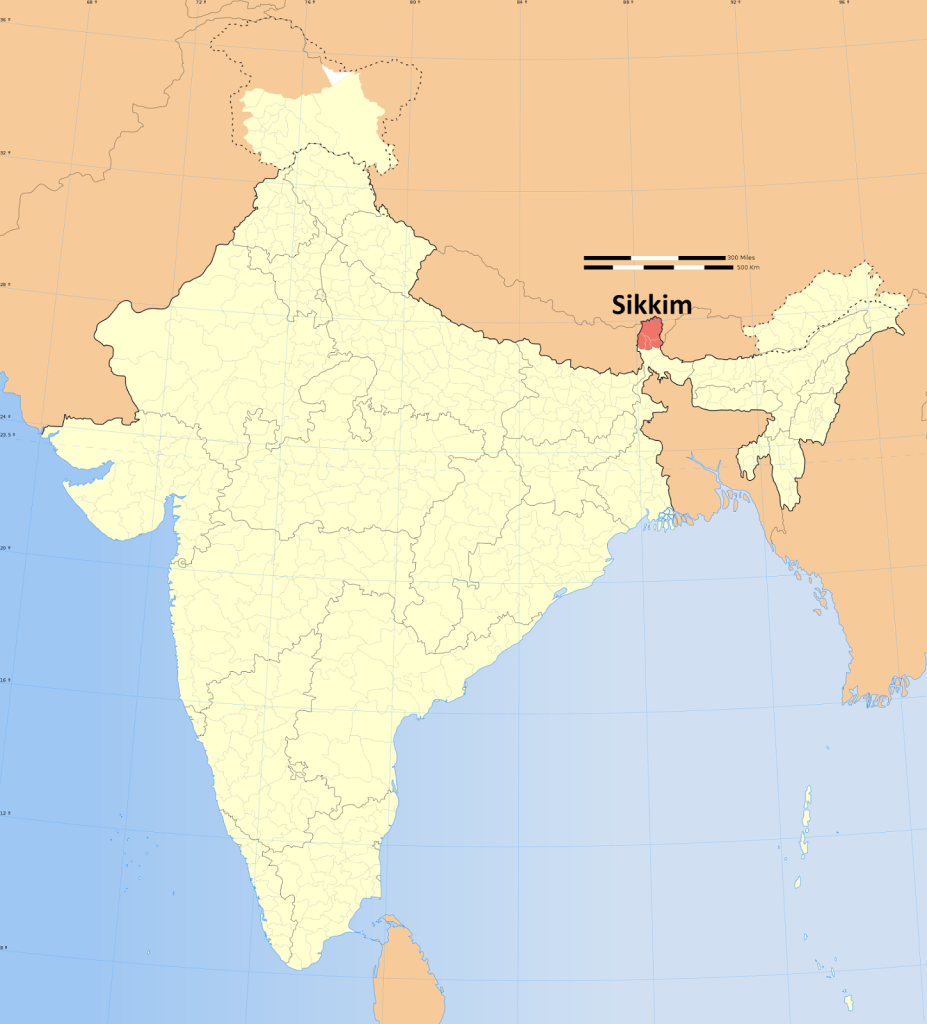Context:
It was on May 16, 1975 that Sikkim became 22nd state of the Union of India.

Relevance:
GS II- Polity and Governance (Federalism)
Dimensions of the Article:
- Attacks during Namgyal Rule
- British Expansion
- Scenario after 1947
- 1974 Elections
- Decision to join India
Attacks during Namgyal Rule
- Beginning with Phuntsog Namgyal, the first chogyal (monarch), the Namgyal dynasty ruled Sikkim until 1975. At one point, the kingdom of Sikkim included the Chumbi valley and Darjeeling; the former being part of China now.
- In the early 1700s, the region saw a series of conflicts between Sikkim, Nepal, Bhutan, and Tibet, which resulted in a shrinking of Sikkim’s territorial boundaries.
British Expansion
- When the British arrived, their expansion plans in the Indian subcontinent included controlling the Himalayan states.
- The kingdom of Nepal, meanwhile, continued with its attempts to expand its territory.
- This resulted in the Anglo-Nepalese war (November, 1814 to March, 1816), also known as the Gorkha war, which was fought between the Gorkhali army and the East India Company.
- Both sides had ambitious expansion plans for the strategically important mountainous north of the Indian subcontinent.
- In 1814, Sikkim allied with the East India Company in the latter’s campaign against Nepal.
- The Company won and restored to Sikkim some of the territories that Nepal had wrested from it in 1780.
The turning point
- A turning point in the history of Sikkim involves the appointment of John Claude White, a civil servant in British India who in 1889 was appointed the Political Officer of Sikkim, which by then was a British Protectorate under the Treaty of Tumlong signed in March, 1861.
- As with most of the Indian subcontinent that the British had under their administrative control, the kingdom of Sikkim, although a protectorate, had little choice in the administration of its own kingdom.
- The British encouraged Nepali migration into Sikkim and it didn’t really happen with the monarch’s consent.
- The Namgyal monarch could not criticise decisions made by the British, but the ruler did complain about this influx of Nepali migrants into the kingdom.
Scenario after 1947
- Three years after India’s Independence in 1947, Sikkim became a protectorate of India.
- In 1950, a treaty was signed between the then Sikkim monarch Tashi Namgyal and India’s then Political Officer in Sikkim, Harishwar Dayal.
- A clause in the treaty read: “Sikkim shall continue to be a Protectorate of India and, subject to the provisions of this Treaty, shall enjoy autonomy in regard to its internal affairs.”
- Geopolitical changes during that time put Sikkim in a delicate position.
- China’s invasion of Tibet in 1949 and Nepal’s attacks on Sikkim throughout the kingdom’s history were cited as reasons why the kingdom needed the support and protection of a powerful ally.
- Further, the talk of persecution of Tibetans after China’s arrival at the scene generated fear of the possibility of Sikkim suffering a similar fate.
Dalai Lama’s Arrival
- In March 1959, the 14th Dalai Lama escaped from Tibet.
- After the Dalai Lama reached Indian borders, he and his entourage settled at the Tawang monastery in Arunachal Pradesh.
- A month later, he travelled to Mussoorie, where he met then Prime Minister Jawaharlal Nehru to discuss the future of the Tibetan refugees who had travelled with him.
- The repercussions of India’s decision to welcome and give refuge to the Dalai Lama sent a message to some in Sikkim that unlike China, aligning with India would guarantee their protection and security, said Bhutia.
- This was the perspective of the ruling elite in Sikkim.
Public discontent against monarchy
- The period between the 1950s and the 1970s marked growing discontent in Sikkim.
- Primarily, there was anger against the monarchy because of growing inequality and feudal control.
- In December 1947, political groups came together and formed the Sikkim State Congress, a political party that supported the merging of Sikkim with the Union of India.
- Three years later, the Sikkim National Party was formed that supported the monarchy and independence of the kingdom.
- A democratic system would have meant a reduction in powers held by the monarch in Sikkim and some researchers believe that the last monarch, Palden Thondup Namgyal, attempted to reduce civil and political liberties.
- Anti-monarchy protests grew in 1973, following which the royal palace was surrounded by thousands of protesters.
- Indian troops arrived after the monarch was left with no choice but to ask New Delhi to send assistance.
- Finally, a tripartite agreement was signed in the same year between the chogyal, the Indian government, and three major political parties, so that major political reforms could be introduced.
1974 Elections
- A year later, in 1974, elections were held, where the Sikkim State Congress led by Kazi Lhendup Dorji won, defeating pro-independence parties.
- That year, a new constitution was adopted, which restricted the role of the monarch to a titular post, which Palden Thondup Namgyal bitterly resented.
- In the same year, India upgraded Sikkim’s status from protectorate to “associated state”, allotting to it one seat each in the Lok Sabha and Rajya Sabha.
- Opposed to the move, the monarch attempted to bring international attention to it soon after.
Decision to join India
- A referendum was held in 1975 where an overwhelming majority voted in favour of abolishing the monarchy and joining India.
- A total 59,637 voted in favour of abolishing the monarchy and joining India, with only 1,496 voting against.
- Sikkim’s new parliament, led by Kazi Lhendup Dorjee, proposed a bill for Sikkim to become an Indian state, which was accepted by the Indian government.
-Source: Indian Express





